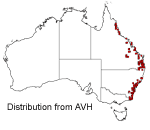Thelychiton speciosus
 |
 |
formerly Dendrobium speciosum
Rock Orchid, Rock Lily
Dendrobium speciosum Sm.
Thelychiton speciosus (Sm.) M.A.Clem. & D.L.Jones
The popular and relatively easy-to-grow orchid known as Dendrobium speciosum has undergone a name change during a major taxonomic revision of the Dendrobium group and is now renamed Thelychiton speciosus.
The epithet speciosus means beautiful and is in reference to the great racemes of showy cream flowers that are borne from the plant’s crown of 2-5 dark-green leaves. These tough, oblong-shaped leaves arise at the top of attractive laterally ribbed canes that can grow to approximately 40cm high.
Much of T. speciosus’s popular appeal lies in its flowers. Individually these are beautiful, being cream to yellow on the outer of the petals and sepals and tending to a reflective white toward the center. The lower petal, the labellum, is attractively spotted with purple. But the flowering stem of the plant produces up to 120 of these flowers many of which may be open at once, producing a spectacular floral show. The exact time of flowering depends on the regions climate. In its cooler distribution flowering occurs from September to October, though this may be earlier in warmer places.
 In
nature T. speciosus is usually found growing as a lithophyte (growing
on rocks) on sandstone or granite in damper sclerophyll forest or occasionally
rainforest, or growing as an epiphyte (from the trunk or branches of another
plant). Its intolerance to frost means its distribution is limited in Victoria
to far East Gippsland and near to the coast in NSW. In QLD its distribution
can venture further inland. In places T. speciosus populations have been
devastated by illegal orchid poachers, but it remains common in many areas.
In
nature T. speciosus is usually found growing as a lithophyte (growing
on rocks) on sandstone or granite in damper sclerophyll forest or occasionally
rainforest, or growing as an epiphyte (from the trunk or branches of another
plant). Its intolerance to frost means its distribution is limited in Victoria
to far East Gippsland and near to the coast in NSW. In QLD its distribution
can venture further inland. In places T. speciosus populations have been
devastated by illegal orchid poachers, but it remains common in many areas.
Its natural growth habit means that this species is not suitable for planting in soil because the root system is not adapted to constant wet. Rather it should be grown in a pot in an epiphytic orchid potting mix. The potting mix described in Appendix 1 is mixed 50:50 with scoria and used by the Australian National Botanic Gardens (ANBG) to grow T. speciosus, and though it may be a bit extravagant for the more casual gardener it provides a guideline for what is required. The most important ingredient is the wood chips.
To grow this plant as an epiphyte or a lithophyte, a form where it can contribute greatly to a garden’s interest and beauty, it is necessary to attach the plant by plastic-covered wire, or even a pair of pantyhose, for at least one growing season. During this period the plant must be well watered to allow for the roots to establish a hold on the substrate. Alternatively it can be pushed into crevices between rocks.
Orchid propagation by seed is difficult but T. speciosus is easy to propagate by dividing the canes where they are attached to each other at the base or by rhizomes. The plant is a tough one so you may need to improvise in your choice of instrument for this task (the ANBG uses a hammer, a chisel and a spade).
T. speciosus is a hardy native plant that requires little attention and fertilization once established, is beautiful both when in flower and when not and would make a spectacular addition to your native garden.
Text by Simon Dwyer (Botanical Intern 2003)
Name meaning Thelychiton speciosus Thelychiton – from two Greek words – thely = female, chiton = covered Dendrobium – means "tree-living" and refers to the epiphytic habit of many of the species of the group. speciosus– means beautiful and is in reference to the great racemes of showy cream flowers |
References
Bishop, T. (1996) Field Guide to the Orchids of New South Wales and Victoria. UNSW Press: Sydney.
Bedford, R. B. (1969) A Guide to Native Australian Orchids. Angus & Robertson: Sydney.
Harden, G. J. (1993) Flora of New South Wales, Volume 4. NSW University Press: Sydney.
Walsh, N. G. & Entwisle, T. J. (1994) Flora of Victoria, Volume 2. Inkata Press: Melbourne.
Clements, M.A. & Jones, D.L. (2002) Nomenclatural changes in the Dendrobieae (Orchidaceae) 1: The Australasian Region. The Orchadian 13(11)
Acknowledgements
Heather Sweet from the ANBG for her very helpful horticultural advice and the potting mix recipe.
Mark Clements from the CPBR for his botanical information and explanations of the taxonomic revisions of the group.
Appendix 1
COARSE EPIPHYTE MIX 45L
red gum chips 30L
orchid potting mix* 15L
cow manure 800ml
blood and bone 120g
*10L soil trolley fines + 5L cocopeat
![An Australian Government Initiative [logo]](/images/austgovt_brown_90px.gif)

